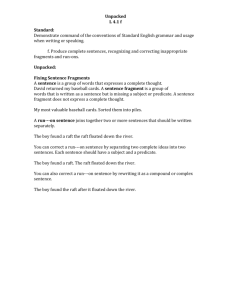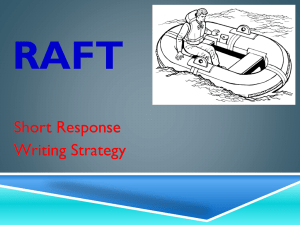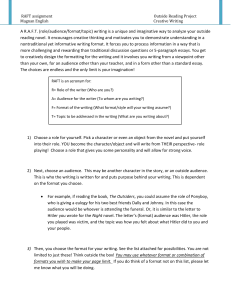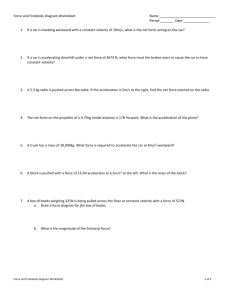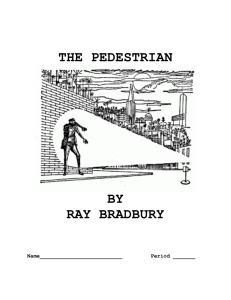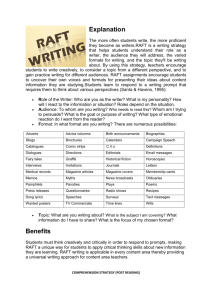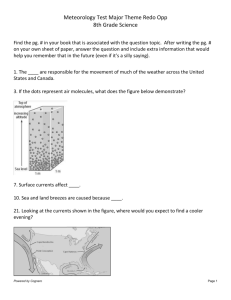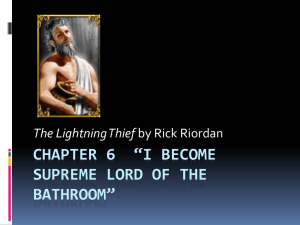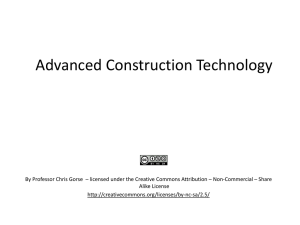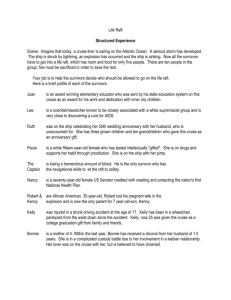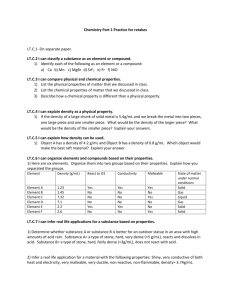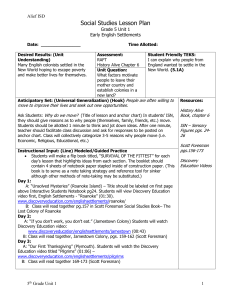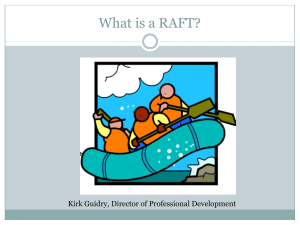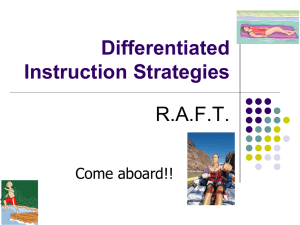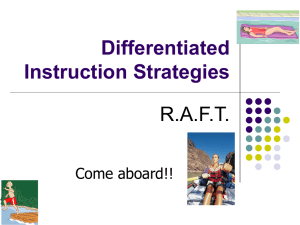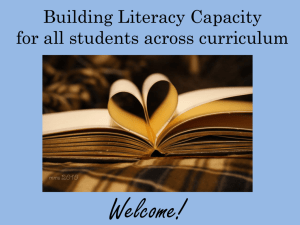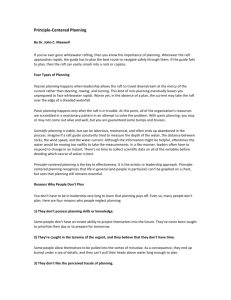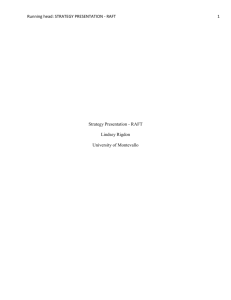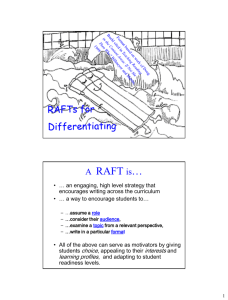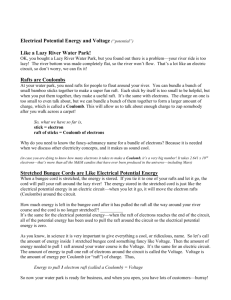RAFT WRITING
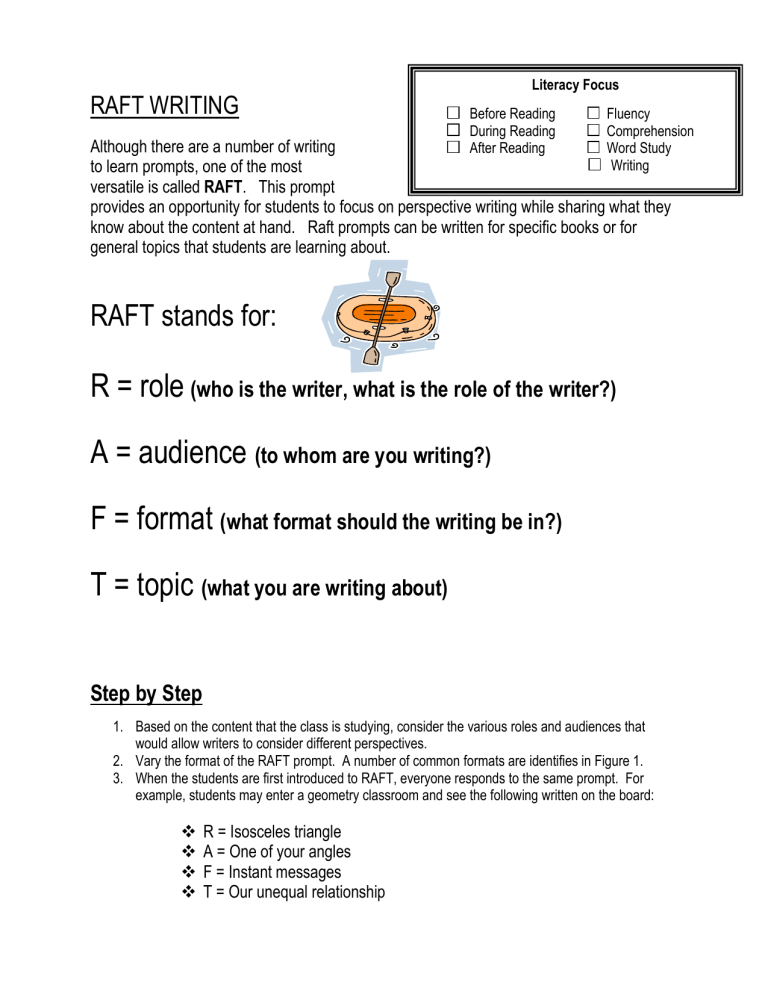
RAFT WRITING
Although there are a number of writing to learn prompts, one of the most versatile is called RAFT. This prompt
Literacy Focus
Before Reading Fluency
During Reading Comprehension
After Reading Word Study
Writing provides an opportunity for students to focus on perspective writing while sharing what they know about the content at hand. Raft prompts can be written for specific books or for general topics that students are learning about.
RAFT stands for:
R = role
(who is the writer, what is the role of the writer?)
A = audience
(to whom are you writing?)
F = format
(what format should the writing be in?)
T = topic
(what you are writing about)
Step by Step
1.
Based on the content that the class is studying, consider the various roles and audiences that would allow writers to consider different perspectives.
2.
Vary the format of the RAFT prompt. A number of common formats are identifies in Figure 1.
3.
When the students are first introduced to RAFT, everyone responds to the same prompt. For example, students may enter a geometry classroom and see the following written on the board:
R = Isosceles triangle
A = One of your angles
F = Instant messages
T = Our unequal relationship
FIGURE 1
Persuasive Writing
Letter
Poem
Instant Message
Diary
Report of Information
Post Card
Brochure
Obituary
“Top 10” Reasons
Classified AD
Newspaper Article
Invitation
How-to-Manual
4.
As students become increasingly familiar with writing RAFTs, vary the prompts so that different students are responding to different, but related, writing assignments.
This provides them with an opportunity to discuss their responses after writing. For example, after reading the book Starry Messenger (Sis, 1996), students whose last name start with a letter between A and M were asked to responds to the following
RAFT:
R = John Paul II
A = The world
F = Papal decree
T = The pardoning of Galileo
Students whose last name started with a letter between N and Z were asked to respond to the following RAFT:
R = Galileo
A = John Paul II
F = Letter
T = I ask for your forgiveness and understanding
APPLICATIONS AND EXAMPLES
U.S. History teacher Mark Seitz wanted his students to consider various perspectives of war. He wanted his students to gain an understanding and appreciation for the differing perspectives on war and the range of winners and losers in a war. He used his social studies textbook as the resource for his students to understand specific battles, the logistics, and timeline. He also used a number of picture books about wars to provide the context around these battles. Inside the front cover of each of the picture books Mr. Seitz wrote a RAFT. He asked his students to select one book per week, read it and to respond to the RAFT. Mr. Seitz read his students’ writing and wrote them back asking questions and challenging their developing ideas. Some of the books Mr. Seitz used include:
Nim and the War Effort (Lee, 1997)
R = Nim
A = Teacher
F = Easy
T= My War Effort
The Wall ( Bunting , 1990)
R = The boy
A = His grandfather
F = Letter
T = We Miss You
Faithful Elephants (Tscuchiya, 1998)
R = General
A = Head Zookeeper
F = Official letter
T = Ensuring the Public’s Safety
Sadako (Coerr, 1993)
R = Sadako
A = Children of the world
F = Open Letter
T = What I’m Wishing For
Star of Fear, Star of Hope (Hoestlandt, 1995)
R = Lydia
A = Helen
F = Letter
T = What Happened to me
